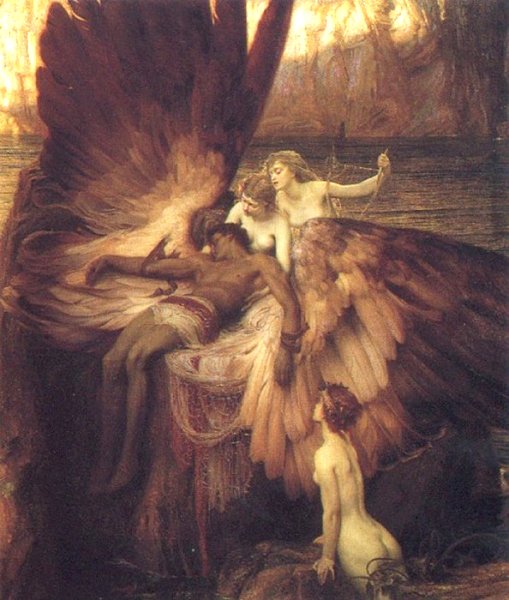
The Lament for Icarus
Herbert Draper, 1898

The Lament for Icarus
Herbert Draper, 1898
Primarily a painter of mythological marine subjects, Draper is often regarded as a successor to Frederic Leighton more by virtue of his consummate technique than his subject-matter. Trained at the Royal Academy and at the Académie Julian in Paris where he worked under Boulanger and Lefèbvre, he was awarded a Gold Medal and traveling scholarship by the Royal Academy in 1889 which enabled him to continue his studies in Europe before completing his education in Rome.
The Lament for Icarus, with its liquid light effects and mastery of form, provides testimony to Draper’s Continental allegiances. The painting is an imaginative adaptation of the Icarus legend which had become a popular pretext for the representation of ephebic beauty following the exhibition of Leighton’s Daedalus and Icarus in 1869. The body of Icarus is shown draped almost languidly on his wings and attended by three sea nymphs who, overawed at this image of physical perfection, are shown lamenting his death. The theme of transience is reiterated by the symbols of the lyre and wreath, and through the passage of sunlight which casts an iridescent glow on distant cliffs. In developing the composition Draper adopted Leighton’s method of making separate figure studies for which he employed four youthful models—Ethel Gurden, Ethel Warwick, Florence Bird and Luigi di Luca—all of whom were Academy professionals. Although Draper abided by the persistent studio convention of posing male and female models separately, by the late nineteenth century audiences had come to accept the frankly erotic interaction of those models on the canvas, so much so that it was now possible to place the male nude under the desiring female gaze. Indeed, so worthy was the work considered when exhibited at the Academy in 1898 that it was purchased by the Chantrey Bequest on behalf of the nation.
The Lament for Icarus may have been conceived as a tribute to Leighton who had died in 1896, but as Simon Toll has recently suggested (Herbert James Draper: A Life Study, by Simon Toll, 2001), it may also be a more private statement of loss, following the death of Draper’s father in 1898. The use of the male body as a vehicle for the projection of subjective emotion is a characteristic of late-Victorian painting and sculpture, and here the rippling wings and drapery gently caress the surface of a body that appears to melt within the arms of the nymph, accentuating the theme of human mutability.
—from Exposed: The Victorian Nude, edited by Alison Smith, 2002
• • • • •
Here are three poems from the 101Bananas Bag Full of Poems that illustrate widely contrasting thoughts and interpretations of the myth of Icarus:
|
Icarus
* * * * * Icarus
* * * * * Icarus
|